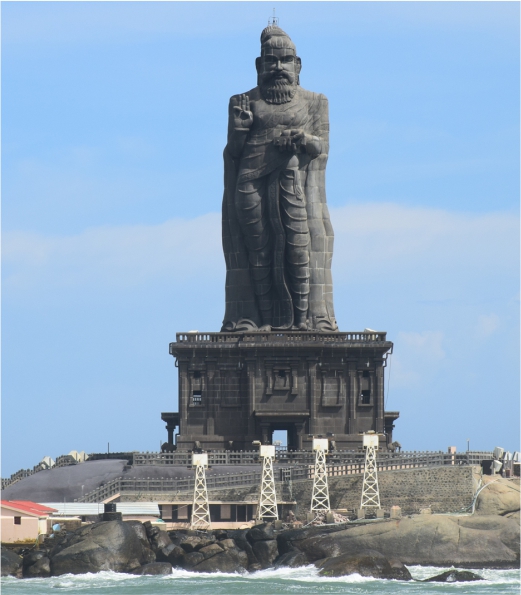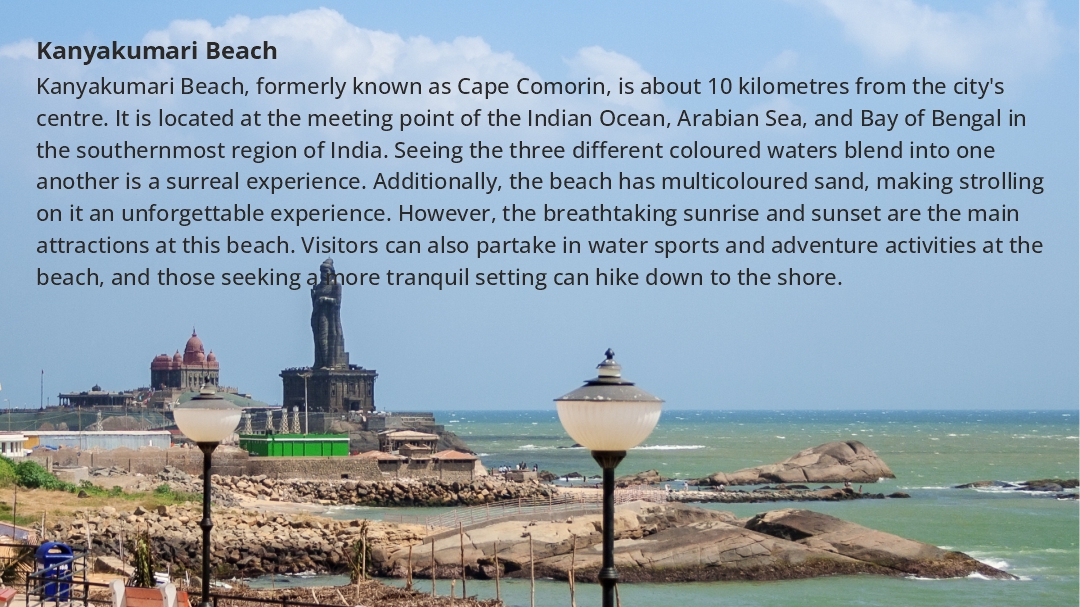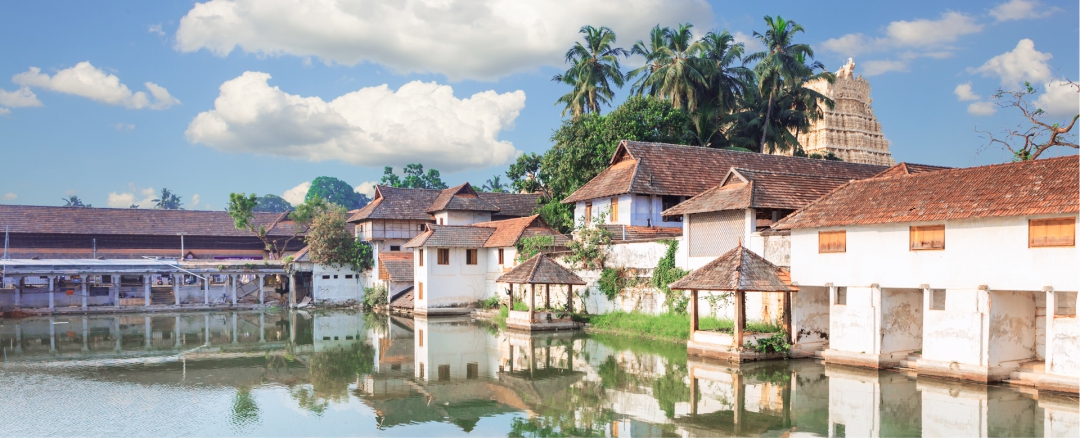Kanyakumari, Tamil Nadu
Been there recently?
Kanyakumari, a small coastal town in Tamil Nadu, is made up of mountainous terrain, palm-lined beaches, paddy fields, and famous monuments. Earlier, it was known as “Cape Comorin,” or “The Land’s End.” It is situated at the intersection of the Indian Ocean, the Arabian Sea, and the southernmost point of peninsular India. It is well known throughout the world for its stunning sunrise and sunset views over the water. Kanyakumari, which is home to stunning waterfalls and historic temples, is a haven for peace and nature lovers. The celestial coincidence of sunset and moonrise can be witnessed simultaneously here. The city of Kanyakumari mesmerises with its beauty and seclusion and is home to both historical landmarks and natural wonders.
Nearby Places to See
Sunset View Point
It is India’s southernmost point, and seeing the sun set at the intersection of the Arabian Sea, Bay of Bengal, and Indian Ocean is an unforgettable experience. It is one of the few locations where it is possible to see both the sunrise and the sunset. Sunset creates a beautiful silhouette of the Vivekananda statue and island.
It is India’s southernmost point, and seeing the sun set at the intersection of the Arabian Sea, Bay of Bengal, and Indian Ocean is an unforgettable experience. It is one of the few locations where it is possible to see both the sunrise and the sunset. Sunset creates a beautiful silhouette of the Vivekananda statue and island.


Thiruvalluvar Statue
The 95-foot-tall stone statue of Saint Thiruvalluvar, a well-known Tamil poet and the creator of the Thirukkural couplets, is a stunning landmark in the area. A 38-foot pedestal holds up the statue, which is perched on a tiny island close to the city. Thirukkaral’s 38 chapters on virtue are represented by this massive sculpture, which weighs around 7,000 tons. The statue is 133 feet tall when the pedestal is added, and it has 133 chapters from the Thirukkural depicted on it. It is said that the stone building can withstand earthquakes and other natural disasters. This sculpture, which was the idea of renowned architect Dr. Ganapati Sthapati, was made by a team of 500 sculptors.
The 95-foot-tall stone statue of Saint Thiruvalluvar, a well-known Tamil poet and the creator of the Thirukkural couplets, is a stunning landmark in the area. A 38-foot pedestal holds up the statue, which is perched on a tiny island close to the city. Thirukkaral’s 38 chapters on virtue are represented by this massive sculpture, which weighs around 7,000 tons. The statue is 133 feet tall when the pedestal is added, and it has 133 chapters from the Thirukkural depicted on it. It is said that the stone building can withstand earthquakes and other natural disasters. This sculpture, which was the idea of renowned architect Dr. Ganapati Sthapati, was made by a team of 500 sculptors.
Vivekananda Rock Memorial
The Vivekananda Rock Memorial, which was constructed in 1970, combines traditional and contemporary Indian architectural styles, particularly those from West Bengal and Tamil Nadu. This famous structure offers breathtaking views of the celestial occurrences of sunrise, sunset, and moonrise. In this building is a life-size bronze statue of Swami Vivekananda holding the well-known parivarjak position. The sanctum sanctorum of the Vivekananda Rock Memorial is enclosed within an outer platform and is known as Shripada Mandapam, one of the memorial’s two main structures. A garbha griham, an inner prakram, and an outer prakram make up the square-shaped hall. Here, Swamiji’s statue is positioned so that it faces the Shripadam directly. The statue of Vivekananda is located in the memorial mandapam, and visitors can also see the footprints of Sri Pada Parai, a virgin goddess, on the same rock.
The Vivekananda Rock Memorial, which was constructed in 1970, combines traditional and contemporary Indian architectural styles, particularly those from West Bengal and Tamil Nadu. This famous structure offers breathtaking views of the celestial occurrences of sunrise, sunset, and moonrise. In this building is a life-size bronze statue of Swami Vivekananda holding the well-known parivarjak position. The sanctum sanctorum of the Vivekananda Rock Memorial is enclosed within an outer platform and is known as Shripada Mandapam, one of the memorial’s two main structures. A garbha griham, an inner prakram, and an outer prakram make up the square-shaped hall. Here, Swamiji’s statue is positioned so that it faces the Shripadam directly. The statue of Vivekananda is located in the memorial mandapam, and visitors can also see the footprints of Sri Pada Parai, a virgin goddess, on the same rock.

Kanyakumari Temple
The Bhagavathy Temple is devoted to the virgin goddess Kanyakumari and is situated at the southernmost point of mainland India, where the Arabian Sea, Indian Ocean, and Bay of Bengal meet. One of the 51 shaktipeethams (locations where the severed body parts of Goddess Shakti fell), the temple is regarded as a symbol of sanctity and unity. Legend has it that Goddess Parvati performed penance in this temple in one of her incarnations as Devi Kanya, or Shree Bhagavathy, in order to wed Lord Shiva. The names Shree Baala Bhadra and Shree Baala are also used to refer to Devi.
The Bhagavathy Temple is devoted to the virgin goddess Kanyakumari and is situated at the southernmost point of mainland India, where the Arabian Sea, Indian Ocean, and Bay of Bengal meet. One of the 51 shaktipeethams (locations where the severed body parts of Goddess Shakti fell), the temple is regarded as a symbol of sanctity and unity. Legend has it that Goddess Parvati performed penance in this temple in one of her incarnations as Devi Kanya, or Shree Bhagavathy, in order to wed Lord Shiva. The names Shree Baala Bhadra and Shree Baala are also used to refer to Devi.


Padmanabhapuram Palace
The magnificent Padmanabhapuram Palace is situated in Thuckalay, 16 kilometres from Nagercoil and 64 kilometres from Thiruvananthapuram. It served as the home of Travancore’s former kings. The palace’s architecture is absolutely stunning. The intricate ceiling carvings and paintings, Belgian mirrors, huge earthen urns, coloured mica on the windows, and murals from the 17th and 18th centuries are just a few of the many architectural features that awe visitors. The palace is full of artwork, including displays in the king’s rooms, inner courtyards, museums, council chambers, dining halls, and queen mother’s palace. It has immaculately finished floors and windows made of coloured mica, as well as a floor that was finished with a glass finish created from lime, coconut, river sand, egg white, lime, and jaggery.
The magnificent Padmanabhapuram Palace is situated in Thuckalay, 16 kilometres from Nagercoil and 64 kilometres from Thiruvananthapuram. It served as the home of Travancore’s former kings. The palace’s architecture is absolutely stunning. The intricate ceiling carvings and paintings, Belgian mirrors, huge earthen urns, coloured mica on the windows, and murals from the 17th and 18th centuries are just a few of the many architectural features that awe visitors. The palace is full of artwork, including displays in the king’s rooms, inner courtyards, museums, council chambers, dining halls, and queen mother’s palace. It has immaculately finished floors and windows made of coloured mica, as well as a floor that was finished with a glass finish created from lime, coconut, river sand, egg white, lime, and jaggery.


-
Destination



